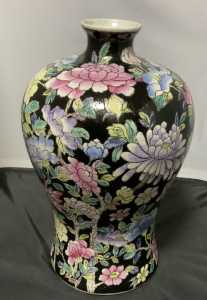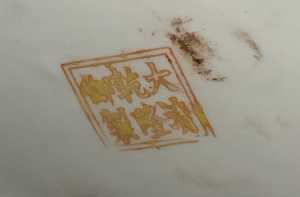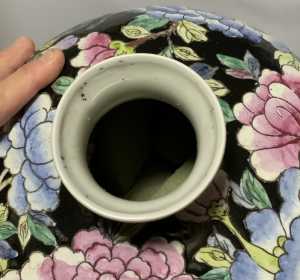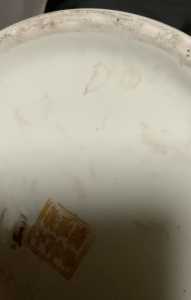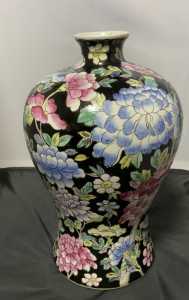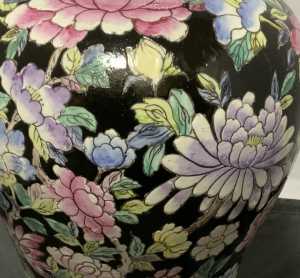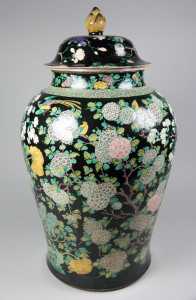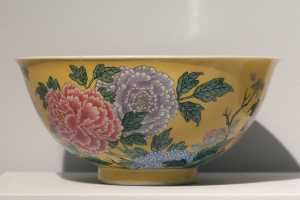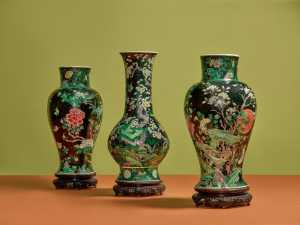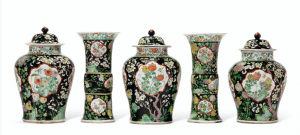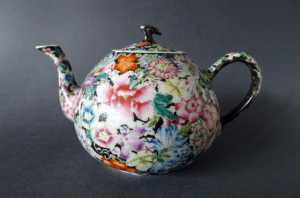The Chinese and Asian Art Forum. For Fans, Collectors and Dealers.
 Basic Rules For the BidAmount Asian Art Forum: Talk about whatever you want. You can even discuss and offer things that are for sale if they are authentic. Maximum image file size per post is 2 MB. Images of 700pxl x 700pxl are optimal if saved at a medium resolution. Be respectful of others and enjoy yourself. Click the YouTube link for a brief tutorial on using the forum. You can also EMBED Videos by cutting and pasting from You-Tube, Vimeo etc.
Basic Rules For the BidAmount Asian Art Forum: Talk about whatever you want. You can even discuss and offer things that are for sale if they are authentic. Maximum image file size per post is 2 MB. Images of 700pxl x 700pxl are optimal if saved at a medium resolution. Be respectful of others and enjoy yourself. Click the YouTube link for a brief tutorial on using the forum. You can also EMBED Videos by cutting and pasting from You-Tube, Vimeo etc.
NOTE: To post an item or add a new post, click open the category title from the FORUM LIST, and CLICK the Blue ADD TOPIC button.
Hi everyone! I purchased this meiping vase. I purchased it because I just fell in love with it and it felt old. I could be completely wrong so I figured I would post it and get your thoughts. The mark on the bottom is something I have never seen before. I would love to hear your thoughts. Thanks in advance for your comments!! This vase is 15” tall.
Yes, it's famille noire. It's a later piece from the PRC—perhaps 1950s or '60s. It bears an apocryphal Qianlong mark (大清乾隆年制).
Sorry, it’s not famille noire. It could be described as famille rose with black ground.
Famille noire is famille verte with black ground, generally rendered in a Kangxi style.
Uour vase is purely decorative.
Agree with Greeno. Dear Jessica, I hope you don’t mind me saying that, please don’t fall into the trap to buy something because it ‚feels old‘. Many things are made to feel old to attract buyers. Feel free to ask here before you buy. Then you could buy something that’s both decorative and really old.
Birgit
Thank you so much for helping me finally figure it out! Have a wonderful day!
Jessica
Sorry, it’s not famille noire. It could be described as famille rose with black ground.
Famille noire is famille verte with black ground, generally rendered in a Kangxi style.
Uour vase is purely decorative.
Ladies and Gentleman,
I migth have a solution.
Technically I wonder if the flower was red and not pink then could it not be classified as Famille noir, but this is too time consuming. The vase indeed could be famille verte and this Famille Noir but for the color pink, then again as Greeno has said it actually is a Famille rose with a black ground, Could we call it a famille rose noir. If indeed 'famille rose noir' is an appropriate term then it would in actual fact be Just as Henry said a famille noir 🙂 and both Greeno and Henry are correct. Indeed it is a term frequently used by auctioneers.
Some musing I did wondering about this.Conclusion this is an area where friendships have been lost and fortunes squandered and fortunes made. Read the sothebys section below if you wish to see what i mean.
Met Museum.
As example
Famille noire vase, Kangxi reign, Jingdezhen
by the Metropolitan Museum of Art.
Famille rose bowl, Imperial porcelain, Jingdezhen
Sothebys
Famille-noire wares comprised many of the most expensive porcelains sold in the first decades of the 20th century. A vase purchased by Frank Partridge for a few hundred pounds was sold in 1919 for the astronomical amount of £12,000 to John D. Rockefeller (1839-1937). The largest collectors of famille-noire were George Salting (1839-1909), who bequeathed his collection to the Victoria & Albert Museum in London, and James A. Garland (1840-1902). The Garland Collection was purchased by Duveen for $500,000, sold to J. P. Morgan (1837-1913), reacquired by Duveen after Morgan’s death with much of the collection going to John D. Rockefeller (1839-1937). Clients and dealers competed vigorously for coveted examples of famille-noire; the intensity resulting in ruptured friendships and even acrimonious lawsuits. The relatively recent reassignment of these wares to the late 19th century does not diminish their appeal or splendor but allows us to appreciate them as a unique expression of a golden age of collecting in the West.
Black was the natal color of the Empress Dowager Cixi (1835-1908), and it is reputed that the palace eunuchs added black grounds to famille-verte wares to please her.Both genuine Kangxi wares with bodies scraped and re-enameled; and entirely new wares were sold to the West as Kangxi period; an attribution that was not seriously questioned until 1974 with John Alexander Pope’s catalog of the Frick Collections porcelains. Pope put forth a convincing argument about the famille-noire wares, observing that all large-scale objects were late 19th century. Although Pope, along with a few other scholars, questioned these wares, it was not until the 1990s and early 2000s that there was widespread agreement and reattribution of large famille-noire wares to the late 19th century.
Gotheborg:
Famille verte
Meaning "the green family". Overglaze enamel decoration on export and Imperial porcelain. Developed during the Ming dynasty from multicolored decorations with tranclucent enamels, applied during secondary firing/s on glazed porcelin. By the end of the 16th century formalized into Wanli wucai - Wanli five color enamels - then further into Kangxi wucai and what now by mostly western scholars is recognized by its French name Famille Verte. The colors are usually red, green, yellow, blue and black. Which name that best describes a certain "five-color decoration" depends on the style of the decoration, where we by "Famille Verte" should assume a Kangxi style and period porcelain shapes and decoration.
Famille noire
Meaning the "black family". This is famille verte but with a black background. Most extant examples are fakes. The best fakes have the black enamel added on real Kangxi pieces in the early 20th century. As a general rule genuine famille noire pieces felt to have been made in the Kangxi reign (1662-1722) have the black color achieved by applying a copper-green lead based enamel over an unfired coating of the dry black cobalt which are also used for black outlines. During the firing the two enamels fused resulting in a deep black effect with a hint of green especially visibly where the two layers doesn't fully cover each other. The general view is also that all pieces where the black is not made up by two layers like this, are later.
@short-dong I appreciate your interest in peaceful compromise. However, this jar is very very far from famille noire, it is misleading to blend the description as famille noire-rose.
I am not aware such a blend has ever existed, but there are rare examples of famille verte-rose where the majority of the design and color resemble Kangxi famille verte, but pink enamels have been introduced. Again, super rare and looks nothing like this jar.
Now, black ground famille rose does exist, but also rare and quite different than this jar, but from a technical standpoint, it’s a more accurate way to describe the jar.
https://www.christies.com/en/lot/lot-4549684
@short-dong Interesting, I wonder how much Rockefeller had to pay for Morgan's collection? One thing is certain, the man who laughed when he found a dime on the street and exclaimed, "I'm bound to be rich," got a deal. Sharon
https://www.christies.com/en/lot/lot-6195915
James A. Garland collection
American Collectors
John Pierpont Morgan (1837 – 1913)
- Morgan stands among the serial collectors as he did not only focus its Art collection on Chinese ceramics. However we can very quickly excuse him as he was so wealthy that he could probably not have found enough to collect focusing only on ceramics… John Pierpont Morgan has also several specificities worth to know. He never really traveled to Asia and he entered it Chinese ceramics collecting at an advanced age, probably around 1900’, i.e. around 65 years old.
What is really interesting is to see that he picked up this subject of collection when coming to maturity. His reputation was not to build any more. His wealth was incommensurate.
The way he built is collection was also very specific as he bought complete collections from the inheritants of former collectors, the best known being the James A. Garland collection (1902 – purchased for 600'000 US$). His collecting effort was not a piece by piece one but more looking like an ogre’s appetite. He had not time to lose.
The assembling and the composition of his collection is very well retraced in the James J. Lally lecture, following the link below. James L. Lally is a famous US Chinese Art expert.
I think we're arguing semantics. I concede that true famille noire is indeed black-ground famille verte, this being a style that was introduced in the Kangxi period.
However, the vase in question is modelled after a black-ground millefleur style that was popular in the Guangxu and Republic periods. Strictly speaking it is best described as black-ground millefleur famille rose, but many sellers throw in the term 'famille noire' to distinguish it from regular famille rose. I feel that this is useful and don't necessarily disapprove of it.
Needless to say, the vase is obviously a vintage piece of negligible value.
For what it's worth, the Chinese use the terms '黑釉粉彩' or '黑地粉彩' to describe this style.
🙂 Now I am completely confused but truly appreciate all of the information. At the end of the day, I love my purchase and enjoy reading everyone’s thoughts. Thanks again for your knowledge and help in trying to identify my treasure!!
Jessica
@henry-higgins Semantics, yes, and more!
It might seem just a matter of wording to experienced collectors, but for beginners, the blurring of ‘the lines’ that define styles opens the door for bastardized pieces like this meiping vase to be perceived by a beginner as possibly genuine famille noire, which are rare and expensive.
I think drawing comparison between a Guangxu black ground famille rose milefleur teapot with this modern Frankenstein vase also adds further shade to the untrained eye as to why they are so different… and they are miles apart as you know.
And while you didn’t mention the fake Qianlong mark, I’ll add that is the icing on the cake to the simple fact that the maker of this meiping vase was not drawing inspiration from genuine pieces, but merely throwing everything but the kitchen sink by combining designs, colors, and motifs to create a ‘pretty’ vase… and I’m not sure that I'd even concede that.
My friend Giovanni has not chimed in on this one, which I’m a little sad about, because while he is often brutal about his criticism of Kangxi copies/fakes, I think the directness of his remarks carry weight in this discussion.
I’m sorry Jessica, but while I’m never seeking to diminish someone else’s happiness about a purchase, your vase is a poor example of Chinese porcelain. There are much nicer modern copies available for purchase that better represent the genuine artistry of famille noire.
Dear Greeno, all,
I have a problem with the site. It often happens that the posts are not updated; I realize that after seeing for days the same posts and not a new post. Then I have to log out and log in again to update the Forum’s pages.
It is what I have just made a few minutes ago and so only now I have seen this discussion.
I completely agree with Greeno. And not only that; I found completely misleading calling famille rose or famille verte vases of the type of this “pseudo famille noire”, only because of some pink or some green.
These classifications were made to differentiate, for example, the typical Kangxi famille verte from the typical Yongzheng famille rose. These classifications, in my opinion, should be only related to the original ware or to the late 19th C / Republic ware which are clearly copying or inspired to the originals.
All the rest, I personally think that should be called polychrome. IMO.
Regards,
Giovanni
@clayandbrush Giovanni, you have to make sure you are signed in each time to the bidamount site or else it will not show you the most recent updates on the forum. When you sign in you should have the option to click on the stay signed in button which can help to reduce the frequency you will need to sign in. Hope that helps.
Thanks for visiting "The BidAmount Asian Art Forum | Chinese Art"
If you sell on eBay, or have a shop feel free to post images and descriptions and links.
Check back often for discussion about the latest news in the Chinese art and antique world. Also find out about the latest Asian art auctions at Sotheby's, Christie's, Bonhams and Tajans.
Auction results for: fine porcelain, ceramics, bronze, jade, textiles and scholar's objects. As well as Japanese, Thai, Vietnamese and other Asian cultures.
Thank you,
Peter Combs
Topics and categories on The BidAmount Asian Art Forum | Chinese Art
Kangxi vases, Kangxi dishes and chargers, Kangxi ritual pieces, Kangxi scholar's objects, Qianlong famille rose, Qianlong enamels, Qianlong period paintings, Qianlong Emporer's court, Fine porcelain of the Yongzheng period. Chinese imperial art, Ming porcelain including Jiajing, Wanli, Xuande, Chenghua as well as Ming jades and bronzes.
The BidAmount Asian Art Forum | Chinese Art
A free Asian art discussion board and Asian art message board for dealers and collectors of art and antiques from China, Japan, Korea, Thailand, Cambodia, Vietnam and the rest of Asia. Linked to all of the BidAmount Asian art reference areas, with videos from plcombs Asian Art and Bidamount on YouTube. Sign up also for the weekly BidAmount newsletter and catalogs of active eBay listing of Chinese porcelain, bronze, jades, robes, and paintings.
The art of calligraphy - and for the ancient Chinese it certainly was an art - aimed to demonstrate superior control and skill using brush and ink. Calligraphy established itself as one of the major Chinese art forms during the Han dynasty (206 BCE - 220 CE), and for two millennia after, all educated men were expected to be proficient at it.
The Museum’s collections of Asian art span nearly five millennia and encompass the cultures of China, the Himalayas, India, Japan, Korea, and Southeast Asia. In 2007, the Museum launched an initiative to create dedicated galleries for the collection, beginning with a gallery for the arts of Korea ...
Chinese art is full of symbolism, in that artists typically seek to depict some aspect of a totality of which they are intuitively aware.
China Online Museum is the finest online museum of Chinese art. It features Chinese calligraphy, painting, ceramics, bronzes, carving, and other artworks.
Chinese Ceramics & Works of Art. Overview Upcoming auctions Contacts Auction results ... Christie’s sales of Chinese ceramics and works of art showcase centuries of Chinese history. Held throughout the year in London, New York, Paris and Hong Kong, they attract a wide audience of collectors and connoisseurs vying for pieces as diverse as ...
Explore Asian Art Week. Contact the Specialist Department. Chinese Paintings ... Senior Specialist, Head of Sale. [email protected]. Tel:+1 212 641 5760. Bid in-person or online for the upcoming auction:Fine Chinese Paintings on 10 September 2019 at New York. Bid in-person or online for the upcoming auction:Fine Chinese Paintings on 10 ...
Discover an abundance of must-see art from all corners of a vast continent at Christie’s NY Asian Art Week. From contemporary classical and Chinese paintings to works with exemplary provenance from the Art Institute of Chicago, our Rockefeller Paza galleries will be full of ancient treasures and contemporary masterworks in a salute to the vibrant arts of Asia.
Sold to benefit The Art Institute of Chicago’s Asian Art Acquisition Fund, the sale features 84 lots with a focus on Ming and Qing porcelains, and offers a rare insight into the taste for collecting Chinese ceramics and works of art in the Midwest from the end of the 19th century through the 1980s. Highlights include two Wanli wucai garlic-head vases, a Qianlong mark and period, blue and ...
Specialist, Chinese Paintings, Christie's London Dr Malcolm McNeill is a Specialist in Chinese Paintings at Christie’s, based in London. He previously worked as an assistant curator of the Chinese collections and the Victoria and Albert Museum in London, as a researcher at the British Museum, and as a translator and tour guide at the National Palace Museum in Taipei.
The Christie's Education 2020 Conference: The Chinese Art Market 18 Jun 2019 Christie’s Education is delighted to announce our first international academic conference in Asia which will take place in Hong Kong from 26-27 November 2020 at the Hong Kong Convention and Exhibition Centre and will run in parallel with Christie’s Hong Kong Autumn Auctions.
The summer Chinese Art sale in Hong Kong will feature works of art from several private collections, including Qing porcelains and textile from the collection of the legendary Chinese art dealer A. W. Bahr (1877–1959), fine gilt bronze Buddhist sculptures from an old Hong Kong collection, an East Asian collection of Qing dynasty wine cups and jades, and a Japanese collection of Song ceramics ...
Sotheby's Chinese Works of Art Department holds two auctions each year in London, New York, Hong Kong and Paris.
Chinese Art - View Auction details, bid, buy and collect the various artworks at Sothebys Art Auction House.
With more than 340 Chinese works of art dating from the Neolithic to the Republic periods, highlights of this sale include a selection of Qing Imperial monochromes from the collection of Arnold and Blema Steinberg, early ceramics from the Art Institute of Chicago and Chinese porcelain and works of art from the collection of Henry Arnhold.
Results: Sotheby's Asia Week achieved $52.4 million in six strong auctions, exceeding pre-sale estimates. With 76.5% of lots sold and 60.3% of lots surpassing high estimates, the Asian art sales at Sotheby's indicate continued collector interest in the finest works of art from China, India and and the Himalayas.
Today's sale of Important Chinese Art will proceed as planned with sessions at 10 AM and 2 PM EDT. Sotheby's will be monitoring the weather conditions throughout the day and will be available to coordinate alternative bidding options should conditions make it difficult for clients to attend the auction in person.
Bonhams Chinese Art department is renowned for offering the finest works of art representing the richness and breadth of China's artistic heritage, particularly Imperial porcelain, white and spinach green jades, cloisonné and Buddhist art. Specialised international auctions are held globally, including London, Hong Kong and San Francisco.
Bonhams : Chinese Works of Art We use cookies to remember choices you make on functionality and personal features to enhance your experience to our site. By continuing to use our site you consent to the use of cookies. Please refer to our privacy and cookie policies for more information.
Bonhams Fine Art Auctioneers & Valuers: auctioneers of art, pictures, collectables and motor cars. We use cookies to remember choices you make on functionality and personal features to enhance your experience to our site. By continuing to use our site you consent to the use of cookies. ... Chinese Art (US) General enquiries
Bonhams : Fine Chinese Art We use cookies to remember choices you make on functionality and personal features to enhance your experience to our site. By continuing to use our site you consent to the use of cookies. Please refer to our privacy and cookie policies for more information.
Bonhams Fine Art Auctioneers & Valuers: auctioneers of art, pictures, collectables and motor cars Bonhams : Asian Art We use cookies to remember choices you make on functionality and personal features to enhance your experience to our site.
Bonhams are international auctioneers of fine Chinese and Japanese art. We specialise in rare Imperial and Export Chinese ceramics and works of art, as well as Japanese ceramics, fine and decorative works of art from the Neolithic Period to the 20th century. View on map
Bonhams Fine Art Auctioneers & Valuers: auctioneers of art, pictures, collectables and motor cars. We use cookies to remember choices you make on functionality and personal features to enhance your experience to our site. By continuing to use our site you consent to the use of cookies. ... Asian Art Bonhams. Work. 22 Queen St.
